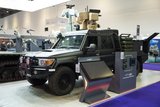Harris receives Poland Falcon radio order
Harris Corporation will supply the Poland Ministry of National Defense with its Falcon III AN/PRC-117G manpack and AN/PRC-152A handheld radios under a new $61 million order announced on 1 July. The radios will enable Poland to better communicate with coalition partners.
The radios will provide Poland’s armed forces with secure wideband combat net radio, tactical satellite and ground-to-air communications. Both radios are equipped with the Harris Adaptive Networking Wideband Waveform (ANW2), which enables military forces to leverage advanced battle management applications such as collaborative chat, streaming video and intelligence collection.
Brendan O’Connell, president, international business, Harris RF Communications, said: ‘Our Falcon III radios will enable Polish military personnel to communicate seamlessly with US and NATO forces during joint warfighting missions. Our radios unite the forces by making it easier to exchange voice, data and situational awareness, even while on the move.’
Harris has deployed more than 40,000 AN/PRC-117G and AN/PRC-152A radios worldwide. They are in use by all branches of the US Department of Defense and more than 15 allied nations.
More from Digital Battlespace
-
![Babcock nears first customer for Nomad AI translation tool]()
Babcock nears first customer for Nomad AI translation tool
Nomad can provide militaries with real-time intelligence, saving critical time on the battlefield.
-
![AUSA 2025: Israel’s Asio Technologies to supply hundreds of improved Taurus tactical systems]()
AUSA 2025: Israel’s Asio Technologies to supply hundreds of improved Taurus tactical systems
Taurus operates alongside the Israel Defense Forces’ Orion system which supports mission management across tens of thousands of manoeuvring forces, from squad leaders to battalion commanders.
-
![AUSA 2025: Kopin pushes micro-LED plans as China moves faster]()
AUSA 2025: Kopin pushes micro-LED plans as China moves faster
The plan for the new displays follows fresh investment in Kopin’s European facilities by Theon and an order for head-up displays in fielded aircraft, with funding from the US Department of Defense.
-
![AUSA 2025: Persistent Systems to complete its largest order by year’s end]()
AUSA 2025: Persistent Systems to complete its largest order by year’s end
Persistent Systems received its largest ever single order for its MPU5 devices and other systems earlier this month and has already delivered the 50 units to the US Army’s 4th Infantry Division.
-
![Aselsan brings in dozens of companies and systems under the Steel Dome umbrella]()
Aselsan brings in dozens of companies and systems under the Steel Dome umbrella
Turkey has joined the family of countries attempting to establish a multilayered air defence system with government approval in August 2024 for the effort landed by Aselsan. Dubbed Steel Dome, the programme joins Israel’s Iron Dome, the US Golden Dome, India’s Mission Sudarshan Chakra and South Korea’s low-altitude missile defence system.
-
![DSEI 2025: MARSS unveils new agnostic multidomain C4 system]()
DSEI 2025: MARSS unveils new agnostic multidomain C4 system
MARSS’ NiDAR system has been deployed using sensors from static platforms to provide detection and protection for static sights, such as critical infrastructure, ports and military bases.




























